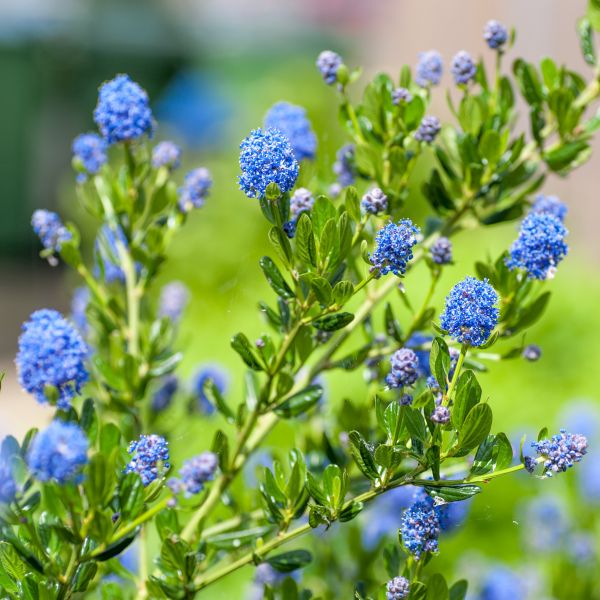

California Mountain Lilac
Ceanothus x 'Concha'
94 reviews
California Mountain Lilac
Ceanothus x 'Concha'
94 reviews
- Drought tolerant and low maintenance
- Attracts pollinators such as butterflies and bees
- Produces fragrant purple flowers in the spring
- Recommended by landscape designers for optimal fit in real yards
$54.00
$78.00
30% Off
- Ships to in 7-10 Days
- Free Shipping Over $150
- Plant Arrival Guarantee
- In Stock
- Free Plant Consult
$200 - Landscape-Approved: Every Plant We Sell Comes With Design Expertise Behind It
1 Gallon
We are sorry, product is currently out of stock due to seasonal availability. Please check the "Related plants available in your area" section below
Not just beautiful - intentionally selected by ShrubHub's 3D landscape design team to fit real-world spaces and maximize yard potential.
Why California Mountain Lilac?
California Mountain Lilac (Ceanothus x 'Concha') is a popular landscaping plant that produces dense clusters of deep blue flowers in late spring and early summer. This evergreen shrub is valued for its drought tolerance, low maintenance, and ability to attract pollinators like bees and butterflies. It thrives in full sun and well-draining soil, making it an excellent choice for California gardens and landscapes. Its compact size and attractive foliage also make it suitable for use as a hedge or border plant
Sunlight
California Mountain Lilac (Ceanothus) requires full sun to thrive. It is a sun-loving plant that needs at least 6 to 8 hours of direct sunlight per day. Insufficient sunlight may lead to weak growth and a decrease in flower production.
Watering
The California Mountain Lilac has a low watering requirement and is highly drought-tolerant once established. It is best to water deeply and infrequently, allowing the soil to dry out between watering to prevent root rot.
Fertilizing
The fertilizer requirement for California Mountain Lilac is not specified, as the plant is typically able to thrive in nutrient-poor soil. Adding organic matter to the soil during planting can promote healthy growth.
Fragrant Beauty: California Mountain Lilac for Your Garden
Introducing the California Mountain Lilac, a captivating shrub that will elevate the beauty of your garden with its stunning flowers and easy-care nature.
Get ready to be mesmerized by the California Mountain Lilac's beautiful deep blue to lavender flowers.
Blooming in early spring, these exquisite blossoms add a burst of color and a touch of elegance to your garden.
The sweet fragrance that accompanies the blooms creates a delightful sensory experience, enveloping your outdoor space in a pleasant aroma.
California Mountain Lilac provides a vital nectar and pollen resource for bees, butterflies, and other beneficial insects, attracting and supporting the local pollinator population.
This shrub is a perfect choice for xeriscaping and firescaping gardens.
It is drought-tolerant and thrives in arid conditions, making it a resilient option for water-wise landscapes.
Additionally, it spreads wider than it grows tall, making it an excellent groundcover shrub that adds texture and beauty to your garden.
Versatility is a defining feature of the California Mountain Lilac.
It adapts well to various landscape settings, including full sun and partial shade.
It has moderate to low moisture needs once established, and it handles a wide range of soil conditions, from clay and sand to poor and rocky soil.
Enjoy the benefits of a low-maintenance plant as the California Mountain Lilac is seldom bothered by deer and can grow without supplemental water once established.
Its unique nitrogen-fixing properties add to its ecological value, enriching the soil and contributing to a healthier garden ecosystem.
Experience the long-lasting beauty of the California Mountain Lilac in your landscape.
Visit our ShrubHub store today and bring this effortless beauty to your garden.
Place your order now and embrace the allure of the California Mountain Lilac!
Plant Information:
| Botanical Name: | Ceanothus x 'Concha' |
| USDA Zones: | 7 - 10 |
| Water: | Low Once Established |
| Exposure: | Full Sun |
| Soil Needs: | Well-Drained |
| Mature Height: | 4 - 8 feet |
| Mature Spread: | 4 - 8 feet |





Pollination Info
Pollination Information for California Mountain Lilac (Ceanothus x 'Concha')
The California Mountain Lilac (Ceanothus x 'Concha') is a popular landscape plant in California due to its beautiful blue flowers and drought-tolerant nature. When it comes to pollination, here's what you need to know:
Pollination Method:
The California Mountain Lilac (Ceanothus x 'Concha') is primarily pollinated by bees, specifically native bees such as solitary bees and bumblebees. Butterflies and hummingbirds may also help with pollination but to a lesser extent.
Flowering Season:
The California Mountain Lilac (Ceanothus x 'Concha') blooms in the spring, typically between March and May.
Pollination Requirements:
The California Mountain Lilac (Ceanothus x 'Concha') is self-fertile, meaning it can pollinate itself and produce fruit without the need for cross-pollination with another plant. However, cross-pollination with another compatible plant can increase fruit set and yield.
Compatible Pollinators:
The California Mountain Lilac (Ceanothus x 'Concha') can cross-pollinate with other Ceanothus species, such as C. thyrsiflorus, C. gloriosus, and C. impressus. Bees are the primary pollinators for these plants.
Pollination Challenges:
The California Mountain Lilac (Ceanothus x 'Concha') faces some pollination challenges due to its early blooming period and the unpredictability of spring weather. If the weather is cold or rainy during the blooming period, bee activity can be reduced, which can impact pollination and fruit set. Additionally, the loss of native bees due to habitat destruction and pesticide use can also impact pollination success.
Pollination Tips:
To improve pollination for the California Mountain Lilac (Ceanothus x 'Concha'), it is recommended to plant it near other compatible Ceanothus species, provide nesting sites for bees, and avoid using pesticides during the blooming period.
FAQ
Frequently Asked Questions - California Mountain Lilac (Ceanothus x 'Concha')
What is a California Mountain Lilac?
A California Mountain Lilac, scientifically known as Ceanothus, is a flowering plant that is native to North America. It is a hardy shrub that can grow up to 15 feet tall with small, dark-green leaves and abundant clusters of fragrant, blue flowers.
What is Ceanothus x 'Concha'?
Ceanothus x 'Concha' is a specific cultivar of the California Mountain Lilac. It is a dense, compact shrub that typically grows to about 5 feet tall and wide. It has shiny, dark-green leaves and profuse clusters of deep-blue flowers that bloom in late spring.
Can I grow California Mountain Lilac in my garden?
If you live in a region with a Mediterranean-like climate that is warm and dry in the summer months and cooler and wetter in the winter, you can likely grow California Mountain Lilac in your garden. They prefer full sun exposure and well-draining soil.
When does Ceanothus x 'Concha' bloom?
Ceanothus x 'Concha' blooms in late spring, typically in May or June. The flowers are abundant and often cover the entire shrub, creating a stunning display.
How do I care for California Mountain Lilac?
California Mountain Lilac is a low-maintenance shrub. It requires very little water once established and should be allowed to dry out between waterings. It does not require fertilizer and should not be pruned except to remove dead or damaged branches.
Can I propagate California Mountain Lilac?
Yes, California Mountain Lilac can be propagated through cuttings taken in late summer or early fall. Make sure to take cuttings that are at least 6 inches long and dipped in rooting hormone before planting in well-draining soil.
What are some common pests or diseases that affect California Mountain Lilac?
California Mountain Lilac is relatively pest and disease-resistant, but it can be susceptible to root rot if the soil is too wet. It may also be affected by spider mites or aphids, which can be treated with insecticidal soap.
Planting & Care
Planting & Care for California Mountain Lilac (Ceanothus x 'Concha')
Planting
- Choose a planting location that receives full sun to partial shade.
- Make sure the soil is well-draining and has good fertility. California Mountain Lilac prefers slightly acidic to neutral soil with a pH range of 5.5-7.0.
- Dig a hole that is twice as wide as the root ball but only as deep as the root ball.
- Add a layer of compost or well-rotted manure to the bottom of the hole and mix it with the existing soil to improve fertility and drainage.
- Remove the plant from its nursery pot and gently loosen the roots. Place the plant in the hole, making sure the top of the root ball is level with the ground surface.
- Backfill the hole with the amended soil and firm it down gently with your hands.
- Water the plant thoroughly to settle the soil and eliminate any air pockets.
- Add a 2-3 inch layer of mulch around the plant to conserve moisture and suppress weeds.
- Water the plant deeply once a week until it becomes established. After the first year, reduce watering to once every 2-3 weeks.
Care
- Prune the plant lightly after it finishes blooming in late spring or early summer to shape it or control its size. California Mountain Lilac blooms on old wood, so avoid pruning it in fall or winter.
- Fertilize the plant with a balanced fertilizer in early spring, following the package instructions for application rates.
- Water the plant deeply during periods of drought or extreme heat. However, do not overwater it, as this can lead to root rot.
- Monitor for pests and diseases, such as aphids, spider mites, root rot, or powdery mildew. Treat infestations or infections promptly with insecticidal soap, horticultural oil, or other appropriate methods.
- Propagate the plant by taking semi-hardwood cuttings in late summer or early fall.
Check Out These Verified Customer Reviews:
Customer Reviews
4.7 out of 5 based on 94 reviews
Thank you! Your review has been submitted.
Absolutely beautiful California Mountain Lilac plant! It arrived in perfect condition and is thriving in my garden. The website was easy to navigate and the shipment was quick. I highly recommend this product.
The California Mountain Lilac I ordered was exactly as described. It was a healthy plant with vibrant flowers. The customer service was also great, answering all my questions promptly. Overall a great experience!
High quality, fast shipping.
Item has been added to your cart.


